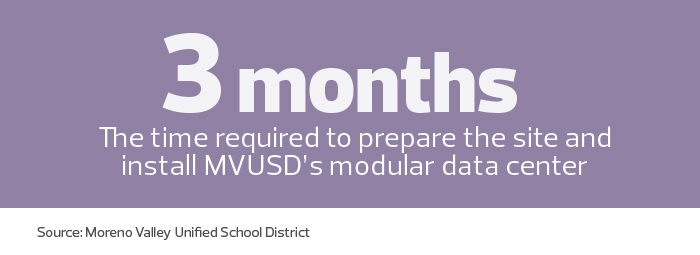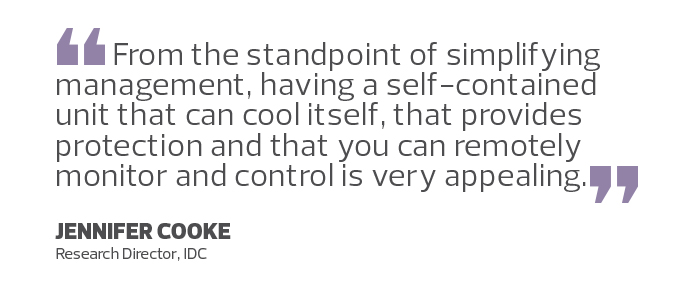K–12 Data Centers Move Toward Modular Designs
Growing school districts have always dealt with the space limitations of their physical grounds and structures. Lately, however, this challenge has evolved: Whereas once the concern involved too-crowded classrooms, now it’s also about the need for new technologies — and where to keep the infrastructure required to make things run. Such was the case at Moreno Valley Unified School District in Southern California, which until last year had housed its data center in a decommissioned restroom at its central office.
“You can imagine what that was like,” says Aaron Barnett, MVUSD’s director of information systems and technology. “We’d pulled out all the urinals and the sinks, but it was still a real mess — not nearly the amount of space we needed.”
For starters, there wasn’t enough room. “The more equipment we put in there, the more concerned we became that a water pipe rupture or air conditioning incident might take our data center down with little or no warning,” says Tim Kelly, MVUSD’s systems administrator. “As our network grew, the need for centralized servers and control systems increased. Demands for physical space, reliable power, HVAC, fire suppression and flooring load limits required us to begin a search for a well-designed, affordable alternative to our makeshift solution.”
A Modular Move Creates Cost Efficiencies
Like many school districts, MVUSD, which includes 40 schools and about 34,000 students, didn’t have the financial resources to build a new data center from scratch. But as it embraced new technologies and internet connectivity, and adapted to the requirements of online state testing, it gradually became clear the district had to do something.
“We have high-speed fiber lines running from all of our schools back to the district office, and from there they connect out to the internet,” Barnett says. The old restroom data center held up admirably under normal conditions, he says, but tended to struggle when the going got rough.
“Eventually, we had a series of power outages that shut down the district office and cut off all the schools.” Before the internet, that might have been manageable, Barnett notes, but that’s no longer the case. “Now, when you lose power, business basically stops; everyone just wants to go home.”

With that in mind, and after exploring other options, in late 2016 Barnett, Kelly and colleagues finally settled on a promising solution. Through a partnership with Schneider Electric, they installed a modular APC data center just outside the district office.
The air-conditioned unit, known as a SmartShelter, sits in the parking lot steps away from Barnett’s office and looks like a shipping container. It comes pre-engineered with integrated hardware and software, and includes everything necessary for plug-and-play connectivity. MVUSD built a protective cinder-block wall around the data center, which was delivered by crane, and made the site wheelchair-accessible.
“Looking back, this was the most cost-effective solution we could find, and it’s a huge improvement to the district’s infrastructure,” Barnett says. “Most of our servers are running VMware, so it’s not like we have a hundred physical boxes in there, but I’m confident now that what we do have is safe and that everything will run reliably, no matter the conditions.”
Schools Find a Reliable and Scalable Solution
MVUSD isn’t the only district to seek an innovative solution to their IT infrastructure needs.
“One of the biggest shifts is toward cloud computing,” says Jennifer Cooke, research director for IDC’s Datacenter Trends and Strategies team. “Institutions are looking at what they’re really there for — to educate kids, not manage IT equipment — and they’re moving toward applications they can have others manage, and which they can pay for as they go.”
Still, Cooke says, school districts continue to need data centers, and for some, a modular setup makes sense: “From the standpoint of simplifying management, having a self-contained unit that can cool itself, that provides protection and that you can remotely monitor and control is very appealing.”
One recent forecast by Research and Markets predicts the market for modular data centers, led by key vendors such as IBM, Eaton and HPE, will grow from $13 billion in 2017 to more than $46 billion by 2022. Modular solutions, the report states, “provide the required scalability and cost effectiveness for setting up new data centers as well as for upgrading” existing infrastructure.
The need for a cost-effective data center upgrade was among the top reasons Tulare City School District, also in California, chose a modular solution. A few years ago, recalls Daryl Shelton, TCSD’s director of information systems, district uptime hinged on the success of a data center he’d built piecemeal in an old classroom.
“I was constantly trying to put things together — to reconfigure racks, improve the cooling system — but with the space we had, it was impossible to get it right,” Shelton says.

Like most districts in the age of Google, Shelton says, TCSD increasingly turns to outside vendors and services to move its data load to the cloud. For now, however, a reliable and scalable onsite data center is still critical, and the one they were using wasn’t up to the job.
“The days of keeping this stuff in a closet are over,” he says. “You need a place that has the proper power, the proper cooling and plenty of space for your racks and wires.”
Reliable Infrastructure Provides Simple Efficiency
There are other solutions to the data center dilemma, of course. Many districts use software-defined data centers to reduce infrastructure costs and simplify IT management while also boosting resiliency. One survey, which was commissioned by data center maker Eaton, found that 48 percent of IT managers report their operations are now “widely virtualized.”
Others, like Lake Crystal Wellcome Memorial School District in Minnesota, have turned to systems like the Nutanix Xtreme Computing Platform to converge all of their servers into a single software stack. “Previously, we had an HPE storage area network and a bunch of HPE servers, and that SAN was at its capacity for storage,” says Technology Director Jacob Quade.
The district’s new 2U Nutanix box, Quade says, is in the same room they’ve always used for their data center, “but it’s tripled our capacity from what we had before, while adding redundancy across the board.”
MVUSD’S Kelly can appreciate that kind of simple efficiency, as well as the need for reliable infrastructure. The district’s data center pod passed its first major test in 2017, he says, when a summer thunderstorm rolled through the area and caused a brief power outage.
As hoped, the unit’s backup battery took over temporarily as a separate diesel generator kicked into gear. A few seconds later, when the brownout was over, the pod automatically transitioned back to utility power and the diesel generator returned to standby mode. The district’s IT systems remained up and running throughout the storm, which meant students, teachers and administrators didn’t notice the outage at all. Kelly says such episodes used to make him cringe, but now he has confidence they’ll be fine. “This data center,” he says, “has become a fortress of reliability.”








